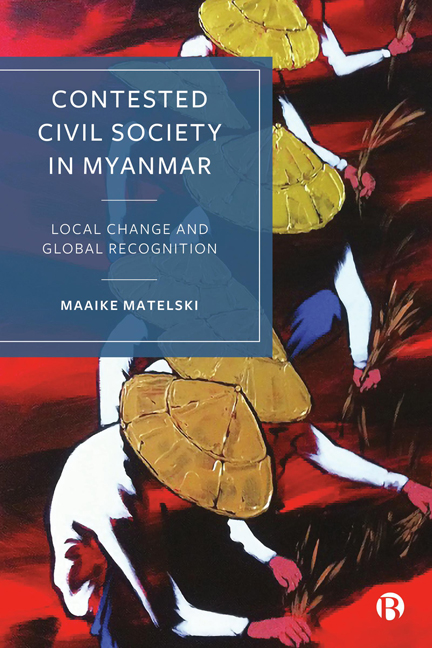Book contents
- Frontmatter
- Contents
- List of Abbreviations and Acronyms
- Acknowledgements
- Introduction: Contested Representation in Burma/Myanmar
- 1 Conflict, Repression and Resistance from Colonialism to Military Rule
- 2 Constructing Civil Society in Myanmar
- 3 Diversity and Fault Lines in Burmese Civil Society
- 4 Room to Manoeuvre under Authoritarian Rule
- 5 Transnational Advocacy Strategies and Pathways to Change
- 6 Competing Frames around the 2010 Elections
- 7 Foreign Aid and the (De)politicization of Civil Society Assistance
- 8 Interrupted Transition and Post-coup Resistance
- Conclusion
- Notes
- References
- Index
Introduction: Contested Representation in Burma/Myanmar
Published online by Cambridge University Press: 28 March 2024
- Frontmatter
- Contents
- List of Abbreviations and Acronyms
- Acknowledgements
- Introduction: Contested Representation in Burma/Myanmar
- 1 Conflict, Repression and Resistance from Colonialism to Military Rule
- 2 Constructing Civil Society in Myanmar
- 3 Diversity and Fault Lines in Burmese Civil Society
- 4 Room to Manoeuvre under Authoritarian Rule
- 5 Transnational Advocacy Strategies and Pathways to Change
- 6 Competing Frames around the 2010 Elections
- 7 Foreign Aid and the (De)politicization of Civil Society Assistance
- 8 Interrupted Transition and Post-coup Resistance
- Conclusion
- Notes
- References
- Index
Summary
Myanmar (also known as Burma; see the discussion of terminology later in the chapter) has endured prolonged periods of military rule and hosts some of the world’s lengthiest internal conflicts. In the early 2010s, cautious hopes for democratic reform flared up on the local and international level, as the military initiated a top-down political transition process. These hopes were extinguished as the military continued to dominate the political landscape and terrorize the population, notably with its horrific violence against the Rohingya in 2017 and with a new military coup in 2021 and the subsequent violent repression of dissent. Throughout the long periods of military rule, the country has faced fierce contestation over political legitimacy and territorial control between the military and various armed and non-armed resistance groups. Burmese society, moreover, has historically been divided along the lines of ethnicity, class, age, gender, religion and rural or urban background. Diversity within the population gained political relevance when Burma was colonized by the British and during the subsequent independence struggle. Ethnic minorities, generally referred to in Myanmar as ‘ethnic nationalities’, make up over 30 per cent of the population and have borne the brunt of the military violence directed against populations in the border areas. The nominally socialist military government which took power in 1962 was confronted with a large-scale popular uprising, resulting in a military reshuffle in 1988. This era of military change-over marked the rise of Aung San Suu Kyi as leader of the political opposition; her party won the elections of 1990 but was not allowed to take power. Meanwhile, armed ethnic resistance continued in the borderlands, while a Burman-dominated ‘democracy movement’ was established, partly from exile, in the 1990s.
In 2003, the military announced its ‘Roadmap to Democracy’, which resulted in a new constitution in 2008 and elections held in 2010. These developments intensified existing debates around the desired future of the country and how this should be achieved. By the time a quasi-civilian government under President Thein Sein took power in 2011, Myanmar’s political transition had caught international attention. Aung San Suu Kyi’s release from house arrest just days after the 2010 elections and her re-entrance into national politics in 2012 increased international interest during what some call Myanmar’s ‘honeymoon period’.
- Type
- Chapter
- Information
- Contested Civil Society in MyanmarLocal Change and Global Recognition, pp. 1 - 16Publisher: Bristol University PressPrint publication year: 2023



